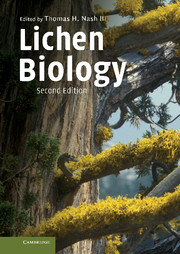Book contents
- Frontmatter
- Contents
- List of contributors
- Preface
- 1 Introduction
- 2 Photobionts
- 3 Mycobionts
- 4 Thallus morphology and anatomy
- 5 Morphogenesis
- 6 Sexual reproduction in lichen-forming ascomycetes
- 7 Biochemistry and secondary metabolites
- 8 Stress physiology and the symbiosis
- 9 Physiological ecology of carbon dioxide exchange
- 10 The carbon economy of lichens
- 11 Nitrogen, its metabolism and potential contribution to ecosystems
- 12 Nutrients, elemental accumulation, and mineral cycling
- 13 Individuals and populations of lichens
- 14 Environmental role of lichens
- 15 Lichen sensitivity to air pollution
- 16 Lichen biogeography
- 17 Systematics of lichenized fungi
- Appendix: Culture methods for lichens and lichen symbionts
- References
- Taxon index
- Subject index
16 - Lichen biogeography
Published online by Cambridge University Press: 05 September 2012
- Frontmatter
- Contents
- List of contributors
- Preface
- 1 Introduction
- 2 Photobionts
- 3 Mycobionts
- 4 Thallus morphology and anatomy
- 5 Morphogenesis
- 6 Sexual reproduction in lichen-forming ascomycetes
- 7 Biochemistry and secondary metabolites
- 8 Stress physiology and the symbiosis
- 9 Physiological ecology of carbon dioxide exchange
- 10 The carbon economy of lichens
- 11 Nitrogen, its metabolism and potential contribution to ecosystems
- 12 Nutrients, elemental accumulation, and mineral cycling
- 13 Individuals and populations of lichens
- 14 Environmental role of lichens
- 15 Lichen sensitivity to air pollution
- 16 Lichen biogeography
- 17 Systematics of lichenized fungi
- Appendix: Culture methods for lichens and lichen symbionts
- References
- Taxon index
- Subject index
Summary
Biogeography is an important, multidisciplinary area of modern science, which is primarily concerned with current and historical distribution patterns of organisms, and operates through observation and detection of pattern at both small and large scales. It attempts meaningful explanations for these observed patterns. Ganderton and Coker (2005) claim that biogeography, because of its multifaceted nature, encourages people to share experiences and expertise, and to see the wider value in the approach of a discipline, with which they may be unfamiliar, or to take a sideways look at their own expertise to see how relevant it is for problem solving in another area. Biogeography functions through the development of hypotheses and theories derived from searching for patterns, testing assumptions and predictions, with new observations. It is above all “… a science of synthesis, bringing in the best aspects of many other disciplines, not only of conventional sciences, but also those of history, mathematics, and language. It relates critically to topics of immediate importance, such as global climate change, the ecology of extinctions, environmental management, and world population growth and resource availability” (Ganderton and Coker 2005). There are now many general biogeography texts available: Humphries and Parenti (1999), Crisci et al. (2003), MacDonald (2003), Ganderton and Coker (2005), Cox and Moore (2005), and Lomolino et al. (2006).
- Type
- Chapter
- Information
- Lichen Biology , pp. 315 - 335Publisher: Cambridge University PressPrint publication year: 2008
- 29
- Cited by

